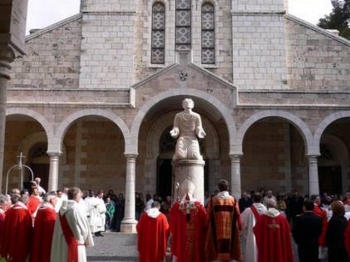The statue of the first deacon and first martyr of Christianity, in the atrium of Saint Stephen’s Basilica

Father Jean-Michel Poffet – Dominican, Knight Commander of the Order of the Holy Sepulchre – was the director of the École Biblique et Archéologique Française for several years. In this article he wanted to tell how the Order helped him to finance the statue of the deacon St. Stephen, which rises in the heart of the building, in the area where tradition has identified the place of his martyrdom, north of the Damascus gate, in Jerusalem.
Here, I would like to express gratitude to the Order for the support it has offered over the years to the famous École biblique of Jerusalem. My short story will have a personal flavour. I was honoured to be appointed director of the École Biblique et Archéologique Française in 1999 and reelected on two occasions until 2008. Until then, I had taught at the Swiss Faculty of Theology at the University of Fribourg.
One evening, in Jerusalem, I was walking and praying in the atrium of St. Stephen’s Basilica, built in 1900 on the remains of the Byzantine church of the fifth century. At the centre of the atrium made of beaten earth, covered by some venerable Byzantine-era stones, an empty column rose. In fact, the martyr was not only stoned in the first century, but his statue was also bombed during the 1947 unrest. Five years later, the friars decided to bury the statue of the beheaded saint in the garden. I felt a deep desire to restore it to its place of honour in front of the basilica. However, I had neither money nor a sculptor at my disposal, but Providence was about to come to our rescue.
One of my confreres spoke to the Sisters of Bethlehem, asking them to pray for this project. They advised him one of their friars, the sculptor Johann. The conversation took place near the place where in the 5th century the relics of Saint Stephen left to be buried in the basilica in Jerusalem. It is difficult not to see a sign in this. However, we still needed to find funds. One day I confided the project to Msgr. Michel Sabbah, then Latin Patriarch of Jerusalem, to whom I was particularly attached. When he came to preside over Mass for the feast of Saint Stephen, he gave me an envelope containing a generous check. I insistently asked him for the name of the benefactor: he was the Grand Master of the Order of the Holy Sepulchre, the late Cardinal Carlo Furno.
Without delay, I made an appointment in Rome to express the gratitude of the Dominicans of Jerusalem. He received me with great kindness, offering me the opportunity to talk about the École biblique, the library, the precariousness of our resources. For my part, I discovered the Order and its support for the Christians of the Holy Land. Other donations finally allowed the statue to be erected and placed in front of the basilica on November 14, 2005, on the eve of the conference we had organized in honour of Father Lagrange. The sculpture was blessed by the Latin Patriarch in the presence of the Consul General of France and many friends, on Saint Stephen’s Day, December 26, 2005.
Since then, the Order continues to support the École. In recent years, this support has taken the form of a salary for a Palestinian employee at the library, the jewel of the École, with its approximately 160,000 works of exegesis with direct access for students and researchers. Furthermore, the Lieutenancy for France financed some maintenance work on the atrium and the basilica. Moreover, the current director – Father Jean-Jacques Pérennès – writes to me that he regularly receives groups of Knights and Dames of the Holy Sepulchre, an opportunity for us to express our gratitude to them and for them to discover a unique work in the Holy Land that could not exist without the help of other Christians, especially those of the Order.
As for your servant, I received the honour of the Investiture on October 3, 2007 at the Patriarchate of Jerusalem, by Bishop Michel Sabbah. My belonging to the Order keeps me in communion of thought, prayer and action with and for the Christians of the Holy Land.
Father Jean-Michel Poffet
(December 2019)



